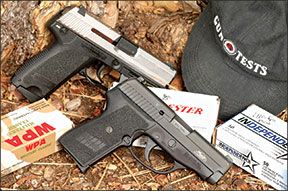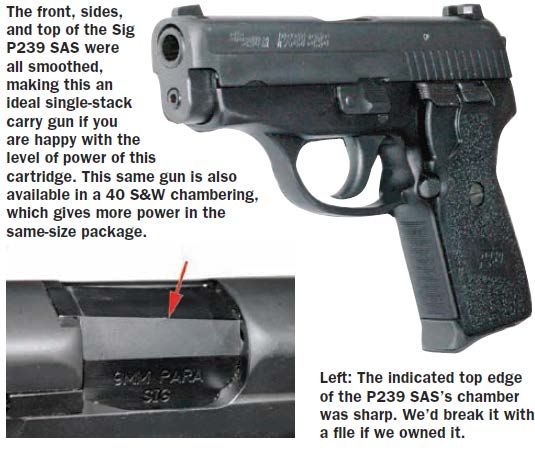In our ongoing look at many of the smaller 9mm handguns out there, we occasionally come across some that are a bit easier to handle than the micro-nines weve looked at during the past year or so. They are generally easier to shoot, though far harder to conceal, and have their place in the scheme of things. In this report we look at the Sig Sauer P239 SAS ($1125) and the H&K USP Compact ($992), two midsize pistols with external hammers but with different approaches to the problem of building a good self-defense handgun.

For example, the Sig always goes to DA mode when you put on its safety, which is not a safety but a hammer dropper. The H&K had one of those too, but in this case its actually a thumb safety which enables cocked-and-locked carry. But if you want to drop the H&Ks hammer, just press down harder on the lever and it drops the hammer in a safe, if sudden, manner. Essentially, the Sig didnt have an external safety, only the hammer-drop lever, or decocker.
We tested with WPA 115-grain FMJ, Winchester BEB 115-grain FMJ, and with Independent 115-grain FMJ. We have found it difficult to buy any JHP ammunition, or that of heavier weights locally, thanks to the ongoing national ammo shortage.
Sig Sauer P239 SAS Gen 2 9mm Luger, $1125
This high-priced pistol was mighty pleasing to us. It had the right look and feel, had a slim and comfortable grip, was smooth on most of the sharp edges, had tritium sights, and had rather simple controls, essentially all the features we like. The overall matte-black finish was well done everywhere. The magazine held only eight rounds, but it gave the gun a slim grip that we all liked. One complaint was the top edge of the barrel at the chamber had a severely sharp, unbroken corner.
Wed have liked checkering on the front strap instead of just the horizontal serrations there that didnt help us grip the gun much. Ditto the back strap, which was actually formed by the wrap-around grips and had only a pebbly surface. The gun was clearly set up for right handers. All the controls, including the magazine catch, slide stop, hammer dropper, and takedown lever were on the left side.
The tritium sights showed us three green dots, or in daylight three white spots that gave an excellent sight picture. The sights were adjustable only by drifting, and we needed to drift the rear to the left to get the gun centered. Elevation was okay for our test ammo, which included only 115-grain loads.
We didnt like the function of the slide lock. When used manually, it was hard to get our thumbs onto it to shove it upward. The grips got in the way. Also, we found the same lever to be set uncommonly far rearward. When we went for it with our thumb, we usually hit the decocker first.
Takedown for cleaning and maintenance was simple. With the gun clear and the slide locked back, rotate the takedown lever 90 degrees and ease the slide forward. The lack of a captive recoil spring was a disappointment. The guide rod had simply a long coil of spring steel that we had to work to get back into place. The inside of the aluminum receiver looked deceptively simple. Much of the guts of this costly gun are hidden under the grip panels, out of the way of prying eyes and accumulating dirt, actually a good thing. The aluminum frame had full-length guide rails. The inside of the gun was all nicely done, in keeping with its high cost.
On the range we had no problems other than the bullet strike being to one side by a couple inches at 15 yards. Accuracy was okay, not stunning, about 2.5 inches overall. The SA trigger was excellent, and the DA pull was long and smooth. Though their DA pulls were of similar weight, the smoothness of the Sigs put it ahead of the H&K, we thought. The gun gave us a feeling of being done just right. It was smooth, efficient, and had the controls and handle professionally set up. It was relatively easy to thumb-cock the hammer for the first shot, if desired. Be sure to always use the decocker to lower it.

Our Team Said: This was a nice pistol, but frankly we could not see the reasons for its high cost. Glocks are just as nice in a professional way for a little over half the price. But if you must have a P239, you have to pay Sigs price. By the way, the same configuration is available in 40 cal or in 357 Sig, but with only seven rounds in the magazine. Its a nice pistol, very much shooter oriented.
H&K USP Compact 9mm Luger, $992
If you want the H&K without the manual safety/decocker, it costs more, $1060. The gun is also available as a 40 or a 45. Prices vary, all slightly higher than the 9mm version. Our test gun was two tone, and there are other finish options. The gun came with two magazines and tritium sights.
The gun felt clumsy to us, and not just because of its slightly fat grip, necessary to accommodate 13 rounds. We suspect the feeling came from the extra size and mass of the big, wide slide. The empty gun felt notably top heavy. Part of the lousy feel may have also come from the relatively ineffective, round-topped checkering molded into the grip straps. However, it was for the most part a well-done pistol, though we thought it was a bit on the massive size. We didnt care for the glare of the white-finished slide and would much prefer a matte-black finish. We also found the white finish of slide slippery, which made us want sharper or deeper serrations to pull it back to chamber a round, or to lock the slide open.
The USP had an accessory rail, which the Sig did not have, for those who want to mount a light or laser on the front. The gun had a long lever on its left side that was the slide stop, and also the takedown pin. Takedown was easy. With the gun unloaded, pull the slide back to line up the notch in the left rail with that pins base, press on the pin from the other side, and the pin can then be withdrawn. Its necessary to drop the hammer to get the slide off the frame. Inside, it was a treat to see the sophisticated recoil spring (are you listening, Sig?) that popped out and back in easily. The barrel has segmented rifling similar to the Glocks. Perhaps we should say Glocks barrels are similar to those of H&K, as H&K was apparently the first modern mass user of the old British curved-segment, rifled barrels of over a century ago. Reassembly was simple. Slip the barrel in place, put the spring assembly in and shove it slightly forward until it clicks into its place under the barrel, put the slide back on, slip in the cross pin, pull the slide rearward to line up the notch with the base of the cross pin, and shove the latter home. This was fast and easy.
We noted the safety can drop the hammer if need be. However, once the hammer is down, its not easy to cock it. In fact we dont recommend trying. We mentioned the decocker drops the hammer suddenly. It actually does it with a great crash, so if silence is what you need at a given moment, you may not want to drop this particular hammer at that moment. We very much liked the ability to carry this gun cocked and locked, thereby bypassing the heavy and hard 11-pound DA pull. The SA pull was not bad, but not as good as that on the Sig. One more odd item with this gun was the magazine release. You press it down, not inward, to drop the mag. This takes some time to learn. Shooters of the Walther P22 will find it natural. The levers are ambidextrous. The thumb safety is not.
On the range we found the sight picture to be excellent, though some might like a wider rear notch. The gun shot slightly to the left, and we would drift the rear sight if we owned it. This was a loaner from a private party, so we left the sights alone. There were no problems with the gun, though one round was slow to enter the chamber. Turned out to be a simple lack of lubrication on this loaner. The gun tried very hard to shoot tiny groups. We had many five-shot groups that had four in a tight bunch of just over an inch, but the fliers ended up giving us overall accuracy on the order of something under 2.5 inches.
Our Team Said: Although we were not very fond of this gun, our testers agreed it was a decent product.
Written and photographed by Ray Ordorica, using evaluations from Gun Tests team testers. GT






























